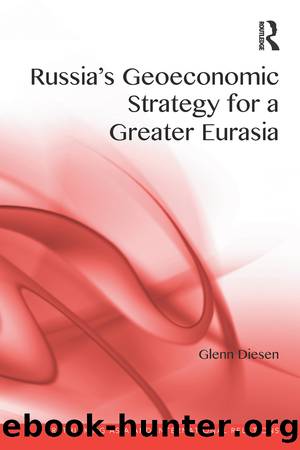Russia's Geoeconomic Strategy for a Greater Eurasia by Glenn Diesen

Author:Glenn Diesen [Diesen, Glenn]
Language: eng
Format: epub
Tags: Political Science, General
ISBN: 9781351815031
Google: xEgrDwAAQBAJ
Publisher: Routledge
Published: 2017-07-06T13:37:19+00:00
From fear of geopolitical dominance to a geoeconomic balance of dependence
A strategic partnership between Russia and China has historically been obstructed by a mutual fear of unfavourable asymmetrical power and subsequent dominance. The Mongol invasion of Russian city states in the 13th century is widely recognised as the origin of Russiaâs âMongol complexâ, the fear of being invaded and ruled by large hordes of âbarbaric peopleâ from the East (Eder 2013: 16). Japanâs military victory over Russia in 1905 revived such fears and was âwidely interpreted as a victory of Mongolian people over the Europeanâ (Neumann 2005: 55). This fear has since been sustained by xenophobic inclinations and the vulnerability of an underpopulated and underdeveloped Far East that could lose its legitimacy if perceived as a remnant European colonial outpost.
Chinaâs apprehensions about Russian dominance originated with Russiaâs imperial expansion into Asia, making it a key contributor to the much-resented âcentury of humiliationâ. More specifically, Russia exploited Chinaâs weakness during the decline of the Qing Dynasty in the 19th century by appropriating more than 1.5 million square kilometres of Chinese territory (Eder 2013: 16). China has been ambiguous about Russiaâs sovereignty over the Far East by referring to the territory transfer as âinequitable treatiesâ and âunequal treatiesâ (Eder 2013: 16; Hyer 2015: 152). As this territory includes a large slice of the Pacific Coast, it diminishes Chinaâs maritime power and sets the foundation for Russia to become a major rival naval power in Asia-Pacific. Cooperation during the Cold War also became a source of Russian domination due to power disparity and lack of diversification. The shared communist ideology and adversarial relationship with the US encouraged Chinaâs full commitment to the Soviet Union, which produced a âleaning-to-one-sideâ policy granting Moscow an uncomfortable amount of leverage.
Following the collapse of the Soviet Union the power symmetry shifted and Russia gradually found itself under Chinaâs shadow. The worsening conditions within Russia throughout the 1990s were juxtaposed with the rapid rise of Chinaâs economy. Since the principal security threats to Russian security had for centuries primarily emanated from the West, the emergence of a more powerful neighbour in the East created âa political earthquake, the earth has movedâ (Trenin 2011b: 227). Moscow was presented with a dilemma because China is an indispensable partner in restoring a global balance of power, while extensive engagement with an increasingly more powerful China would gradually enhance regional imbalance and condemn Russia to the untenable role of a subordinate âlittle brotherâ. In contrast, China can be more flexible to make Russia more comfortable since Beijing is not threatened by a Russia that is stable and less powerful (Lukin 2015d).
Moscow aimed to use its potential partnership with China as a tool to increase its own âmarket valueâ or bargaining power in the West (Blank 2015: 166). The prospect of a Sino-Russian partnership has been instrumental in constructing a âGreater Europeâ as it was intended that the West should be faced with the dilemma of either accommodating Russia or risk a Sino-Russian alliance.
Download
This site does not store any files on its server. We only index and link to content provided by other sites. Please contact the content providers to delete copyright contents if any and email us, we'll remove relevant links or contents immediately.
Incentives and Prosocial Behavior by Incentives & Prosocial Behavior(385)
Reframing Difference in Organizational Communication Studies: Research, Pedagogy, and Practice by Dennis K. Mumby (editor)(329)
Financial Markets, Public Policy, and the East Asian Miracle by Financial Markets Public Policy & the East Asian Miracle(295)
The 21 Irrefutable Truths of Trading: A Trader's Guide to Developing a Mind to Win by John Hayden(256)
Handbook of Intercultural Communication and Cooperation (9783666403279) by Unknown(251)
Human Security in Turkey by Alpaslan Özerdem Füsun Özerdem(243)
Human-Computer Interaction by unknow(237)
Fandom Analytics by Michael Lewis(231)
How the World Became Rich: The Historical Origins of Economic Growth by Mark Koyama & Jared Rubin(230)
Guns of the World by Unknown(229)
Inheritance and Wealth Inequality in Britain by Harbury Colin;Hitchins David;(226)
Asset Integrity Management Systems a Complete Guide - 2020 Edition (9780655989844) by Blokdyk Gerardus(214)
Food Security, Affordable Housing, and Poverty by Ahmet Suayb Gundogdu(214)
Creative problem solving for managers by Developing Skills for Decision Making & Innovation(203)
The Way of the Wall Street Warrior by Dave Liu & Adam Snyder(201)
Beyond Positivism, Behaviorism, and Neoinstitutionalism in Economics by Deirdre Nansen McCloskey(201)
The Delusions of Economics by Gilbert Rist;(194)
Diminishing Returns by Mark Blyth(181)
The Inclusion Toolbox by Jennifer A. Kurth & Megan Gross(181)
